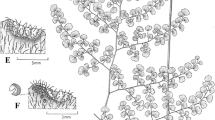Abstract
Floral pigments of 30 taxa, representing five informally ranked subgeneric complexes(Linum schiedeanum, L. virginianum,L. neomexicanum, L. sulcatum, andL. rigidum) of yellow-flowered North American flaxes, were examined by paper chromatography. Earlier studies, based on comparative gross morphology, chromosomal complements, and pollen structure, led to the conclusion that members of theL. schiedeanum complex may be the most primitive and that theL. virginianum, L. neomexicanum, andL. rigidum complexes may have been derived independently, the latter via a taxon similar toL. sulcatum. Data from both carotenoids and flavonoids support this scheme. Spectral analysis reveals the exclusive presence of the Β-carotenoid, violaxanthin, in the X.schiedeanum, L. virginianum, L. neomexicanum, andL. sulcatum com-Taxa of theL. rigidum complex, with the exception ofL. subteres, possesplexes. exclusively the α-carotenoids, lutein and its 5, 6-monoepoxide.L. subteres, in its production of violaxanthin, provides a chemical link to the other complexes, though possession of several species-specific flavonoids suggests an early divergence from other members of theL. rigidum complex. Distinctions in the Chromatographic patterns of quercetin, luteolin, and other flavonoid compounds were found among the five groups. In general the loss of flavonoid pigments may be correlated with increased morphological specialization. Identical patterns in certain species of theL. schiedeanum andL. virginianum complexes support the presumed relationship between these two groups.
Similar content being viewed by others
Literature Cited
Block, R. J., E. L. Durrum, G. Zweig, R. Lastrange, W. H. Wingerd, &Kathryn W. Weiss 1958. A Manual of Paper Chromatography and Paper Electrophoresis. (Ed. 2). New York: Academic Press, xi + 710 pp.
Davies, B. H. 1965. Analysis of carotenoid pigments, pp. 489–532.In: Goodwin, T. W. (Editor). Chemistry and Biochemistry of Plant Pigments. New York: Academic Press. viii + 583 pp.
Dillman, A. C. 1933. Chromosome numbers in flax(Linum). Science78(2027): 409.
Eigen, E., M. Blitz, &E. Gunsberg 1957. The detection of some naturally occurring flavanone compounds on paper chromatograms. Arch. Biochem. & Biophys.68(2): 501, 502.
Goodwin, T. W. 1952. The Comparative Biochemistry of the Carotenoids. London: Chapman & Hall, x + 356 pp. (Republished in 1954 by Chemical Publishing Co., New York.)
— 1955. Carotenoids, pp. 272–311.In: Paech, K. & M. V. Tracey (Editors). Modern Methods of Plant Analysis. Vol. III. Berlin: Springer-Verlag, xii + 790 pp.
Harborne, J. B. 1967. Comparative Biochemistry of the Flavonoids. London & New York: Academic Press, viii + 383 pp.
Harris, Betty D. 1968. Chromosome numbers and evolution in North American species ofLinum. Amer. Jour. Bot.55: 1197–1204.
Jurd, L. 1962. Spectral properties of flavonoid compounds, pp. 107–155.In: Geissman, T. A. (Editor). The Chemistry of Flavonoid Compounds. New York: Macmillan Co. viii + 666 pp.
Karrer, P. &E. Jucker 1950. Carotenoids. Amsterdam & New York: Elsevier Publishing Co., Inc. x + 384 pp.
Krinsky, N. I. &T. H. Goldsmith 1960. The carotenoids of the flagellated alga,Euglena gracilis. Arch. Biochem. & Biophys.91(2): 271–279.
Markham, K. R. &T. J. Mabry 1968. A procedure for the ultra-violet spectral detection of ortho-dihydroxyl groups in flavonoids. Phytochemistry7: 1197–1200.
McClure, J. W. &R. E. Alston 1966. A chemotaxonomic study of Lemnaceae. Amer. Jour. Bot.53: 849–860.
Mosquin, T. &Dianne E. Hayley 1967. Evolutionary relationships of the southern Florida populations ofLinum rigidum (Linaceae). Canadian Jour. Bot.45: 1277–1283.
Rogers, C. M. 1963. Yellow flowered species ofLinum in eastern North America. Brittonia15: 97–122.
— 1969. Relationships of the North American species ofLinum (flax). Bull. Torrey Bot. Club96: 176–190.
Valadon, L. R. G. &Rosemary S. Mummery 1967. Carotenoids of certain Compositae flowers. Phytochemistry6: 938–988.
Xavier, K. S. 1967. Taxonomic implications of electron and light microscopic studies ofLinum pollen. Thesis: Ph.D. Wayne State Univ., Detroit. 145 pp.
— &C. M. Rogers 1963. Pollen morphology as a taxonomic tool inLinum. Rhodora65: 137–145.
Author information
Authors and Affiliations
Rights and permissions
About this article
Cite this article
Giannasi, D.E., Rogers, C.M. Taxonomic significance of floral pigments in linum (Linageae). Brittonia 22, 163–174 (1970). https://doi.org/10.2307/2805810
Issue Date:
DOI: https://doi.org/10.2307/2805810




